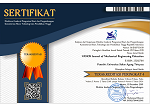Design Project-Based Learning Multimedia for Vocational Education Students
Abstract
This study aims to change activities in the technical implementation of project-based learning in vocational education. Real-life learning activities packaged in project-based learning multimedia are believed to be able to foster student creativity. The technique of preparing learning multimedia is designed using the Instructional Successive Approximation Model (SAM I) because it is more flexible. Data collection techniques were obtained from a survey of multimedia learning needs analysis in pneumatic, hydraulic engineering (N=10), and cooling systems (N=10). The learning multimedia design was evaluated through content validity tests by experts totaling (N=4). The needs analysis results showed that most students did not use multimedia, and they used several methods to develop creativity into products, so multimedia was needed. The results of another study through the content validity test obtained learning multimedia evaluation data with an average score of the quality of learning design and quality of learning multimedia engineering (0.84) that met the "valid" aspect, so it can be concluded that this learning multimedia is suitable for implementing project-based learning in vocational education.
Keywords
Full Text:
PDFReferences
P. Nilsook, P. Chatwattana, and T. Seechaliao, “The Project-based Learning Management Process for Vocational and Technical Education,” High. Educ. Stud., vol. 11, no. 2, p. 20, 2021.
R. Mursid, A. H. Saragih, and R. Hartono, “The Effect of the Blended Project-based Learning Model and Creative Thinking Ability on Engineering Students’ Learning Outcomes,” Int. J. Educ. Math. Sci. Technol., vol. 10, no. 1, pp. 218–235, 2022.
S. Suwarno, W. Wahidin, and S. H. Nur, “Project-based learning model assisted by worksheet: It’s effect on students’ creativity and learning outcomes,” JPBI (Jurnal Pendidik. Biol. Indones., vol. 6, no. 1, pp. 113–122, Mar. 2020.
K. KOVÁCSNÉ PUSZTAI, “Evaluation of Project-Based Learning,” Acta Didact. Napocensia, vol. 14, no. 1, pp. 64–75, Jul. 2021.
E. V. Soboleva, T. N. Suvorova, A. V. Grinshkun, and M. M. Nimatulaev, “Formation of Group Creative Thinking When Working with Virtual Walls,” Eur. J. Contemp. Educ., vol. 10, no. 3, pp. 726–739, 2021.
A. O. Asojo and H. Vo, “Pedagogy + Reflection: A Problem-Based Learning Case in Interior Design,” Int. J. Des. Learn., vol. 12, no. 2, pp. 1–14, Jun. 2021.
S. Puri, “Effective learning through the case method,” Innov. Educ. Teach. Int., vol. 59, no. 2, pp. 161–171, 2022.
K. Jones and J. D. Mendez, “Enhancing learning with 3D print technology: A case study of problem based learning,” J. Educ. Bus., vol. 96, no. 3, pp. 187–194, 2021.
N. Setiyawati and N. Meilani, “The effectiveness of videos and pocket books on the level of knowledge and attitudes towards stigma people with HIV/AIDS,” J. Educ. Learn., vol. 14, no. 4, pp. 489–494, Nov. 2020.
K. Laosethakul and T. Leingpibul, “Investigating Student Perceptions and Behavioral Intention to Use Multimedia Teaching Methods for the SAP ERP System,” 2021.
M. A. Hamid, L. Yuliawati, and D. Aribowo, “Feasibility of electromechanical basic work e-module as a new learning media for vocational students,” J. Educ. Learn., vol. 14, no. 2, pp. 199–211, May 2020.
L. Sofiana and S. M. Ayu, “Pocket Book to Enhance Knowledge and Attitude Regarding Prevention of Soil-transmitted Helminth,” Int. J. Eval. Res. Educ., vol. 6, no. 3, pp. 252–256, 2017.
H. van der Meij, J. van der Meij, T. Voerman, and E. Duipmans, “Supporting motivation, task performance and retention in video tutorials for software training,” Educ. Technol. Res. Dev., vol. 66, no. 3, pp. 597–614, Jun. 2018.
B. Czerkawski and M. Berti, “Learning experience design for augmented reality,” Res. Learn. Technol., vol. 29, 2021.
C. A. Ali, “A comparative study of SAM and ADDIE models in simulating STEM instruction,” African Educ. Res. J., vol. 9, no. 4, pp. 852–859, Oct. 2021.
O. L. Agudelo and J. Salinas Ibáñez, “Flexible Learning Itineraries Based on Conceptual Maps,” J. New Approaches Educ. Res., vol. 4, no. 2, pp. 70–76, Jul. 2015.
P. Mehran, M. Alizadeh, I. Koguchi, and H. Takemura, “Designing and developing a blended course: toward best practices for Japanese learners,” in CALL in a climate of change: adapting to turbulent global conditions – short papers from EUROCALL 2017, Research-publishing.net, 2017, pp. 205–210.
C. Wolverton and B. G. Hollier, “Guidelines for Incorporating Active Learning Into the Design of Online Management Courses Utilizing the Successive Approximation Model (SAM).,” Int. J. Educ. Dev. using Inf. Commun. Technol., vol. 18, no. 1, pp. 264–274, 2022.
L. P. Le Nhat and V. L. T. Kieu, “M-Learning and Learning Autonomy - Needs Analysis and Suggested Model,” Educ. Q. Rev., vol. 4, no. 4, Dec. 2021.
M. Gabriela and M. Susana, “Content Validity of a Questionnaire to Assess Parental Involvement in Education,” Eur. J. Psychol. Educ. Res., vol. 4, no. 2, pp. 83–95, Dec. 2021.
N. C. Basjaruddin and E. Rakhman, “Implementation of Project Based Learning in Mechatronic Lab Course at Bandung State Polytechnic,” Int. J. Eval. Res. Educ., vol. 5, no. 4, p. 284, 2016.
Y. Patarakin and O. Shilova, “Concept of Learning Design for Collaborative Network Activity,” Procedia - Soc. Behav. Sci., vol. 214, pp. 1083–1090, Dec. 2015.
DOI: http://dx.doi.org/10.30870/vanos.v7i2.17021
Refbacks
- There are currently no refbacks.

This work is licensed under a Creative Commons Attribution 4.0 International License.


.png)
.png)
